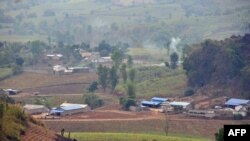Media reports say Chinese authorities are putting up a barrier along their southeastern border with Shan State, a volatile part of Myanmar, a move some analysts believe will stop coronavirus-infected people from sneaking in while deterring Chinese casino gamblers and their debt-collection gangs from sneaking to the other side.
Authorities in Southeastern China are putting up fences along the border with Myanmar’s Shan State, according to a November 26 report on The Irrawaddy news website. It says the Southeast Asian side’s military has sent a protest letter.
Construction of the 3-meter-high fence started earlier this year, Radio Free Asia reported this month. The report said about 660 kilometers of fencing are finished.
The two governments enjoyed strong political relations before 2011 when a military junta ruled Myanmar. Ties have wobbled since then as largely impoverished Myanmar looks to third countries for investment and frets over a construction debt to China. But last year Myanmar state counsellor Aung San Suu Kyi looked to China as a buffer against international criticism over her government’s persecution of the Muslim Rohingya minority.
The fencing would help stop COVID-19 from moving north into China, analysts and Chinese media say. Myanmar reports about 118,000 cases, mostly from spikes in October and November. China, the disease’s apparent source, brought its outbreak under control in March during rigorous lockdowns.
China worries that an outbreak from abroad would “ravage” the economy, Nagy said. China has suspended entry by nationals of 10 other countries on health fears, business consultancy Dezan Shira & Associates said in November.
The border barrier at the same time could help stop Chinese nationals from entering the Shan State region of Kokang to gamble.
Casinos, spas and hotels have made Kokang a “major gambling center” where Chinese spend lavishly and gangs kidnap debtors, said Priscilla Clapp, former permanent charge d’affaires at the U.S. Embassy in Myanmar. Local elected officials operate some of the casinos, she added.
“There’s a lot of criminal violence going on, and I think the Chinese, since it’s really right there on the border with Kokang, aimed at shutting off the border point,” Clapp said.
Chinese authorities have cracked down against citizens who gamble in Myanmar, where visitors are also subject to conflicts between government forces and armed ethnic groups, Beijing’s state-run Global Times news website said in 2016. It quoted a Chinese gambler who had lost hundreds of thousands of dollars and was considering suicide.
Some analysts point to Myanmar’s drug trade as another reason for the border fences, which threaten to disrupt a supply route into China. In May, Myanmar police seized one of Southeast Asia's largest hauls of the synthetic opioid liquid fentanyl.
Myanmar’s Wa State, which borders China, generates billions of dollars’ worth of drugs, said Thitinan Pongsudhirak, political science professor at Chulalongkorn University in Bangkok.
The two sides are no strangers to border walls, and Myanmar might ultimately accept the latest one if it keeps criminals out or makes its own people stay home, said Kwei-bo Huang, vice dean of the international affairs college at National Chengchi University in Taipei.
“If Myanmar doesn’t want its people going across the border, then they won’t necessarily be unhappy that there’s a wall that can hold back their people and not let them run away,” Huang said.
On other fenced border sections, Chinese pass money through holes to vendors on the other side, said Huang, who has visited the 2,227-kilometer-long demarcation line.
Chinese officials have not formally announced reasons for the latest border fence, analysts say.
But Chinese dynasties and governments have tried to “consolidate” the border for millennia, said Thant Myint-U, a Myanmar historian and former public servant. Geographic barriers between the Irrawaddy river valley of Myanmar and core Chinese populations are “now being breached,” the historian said.





